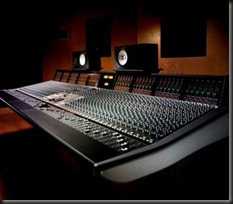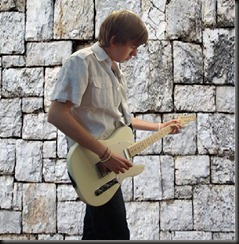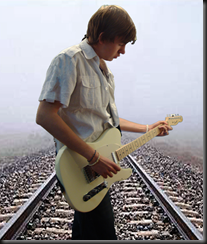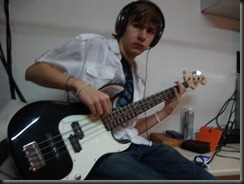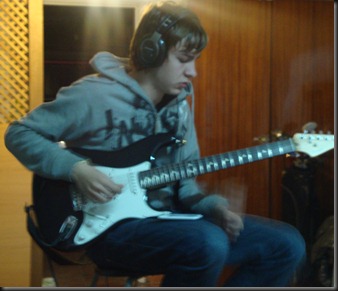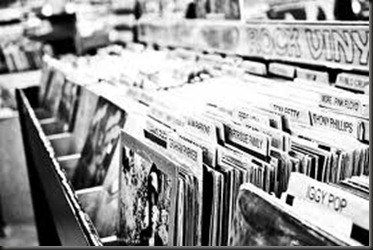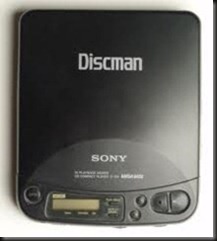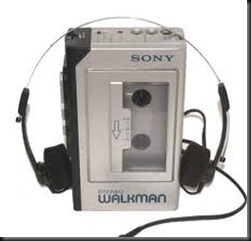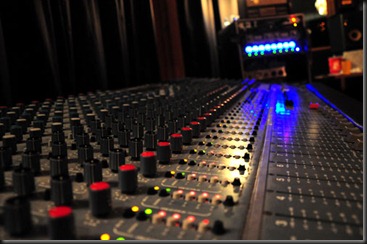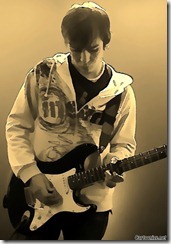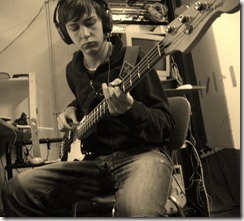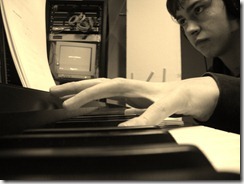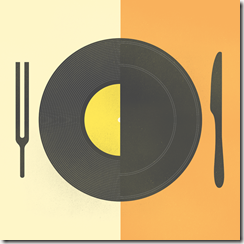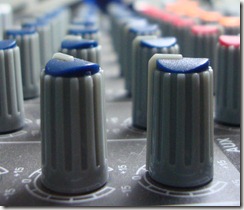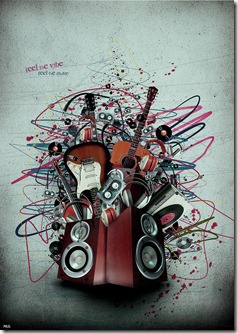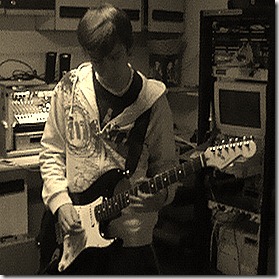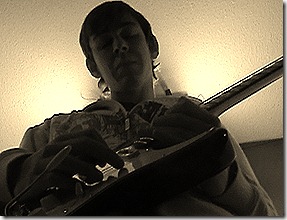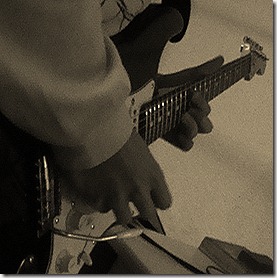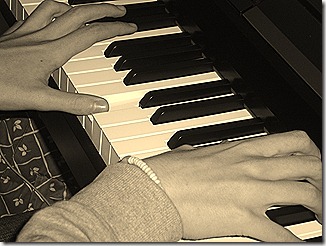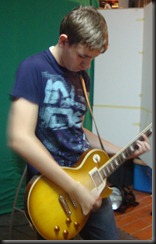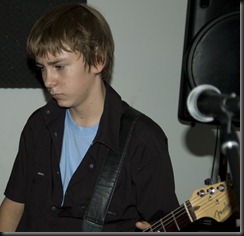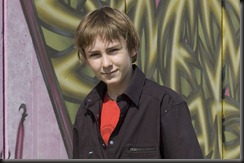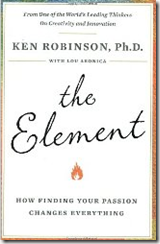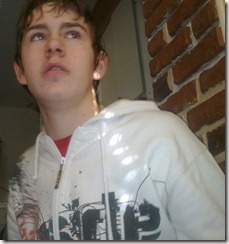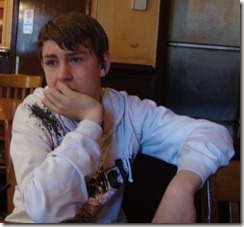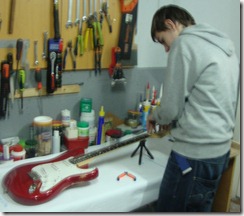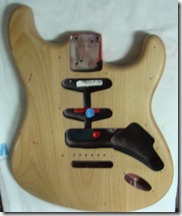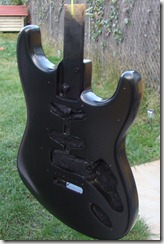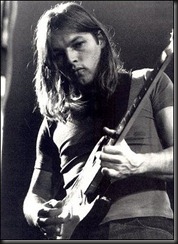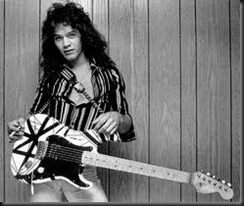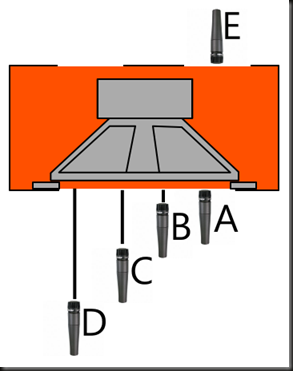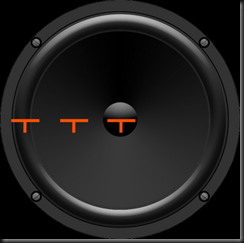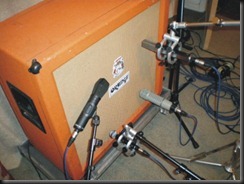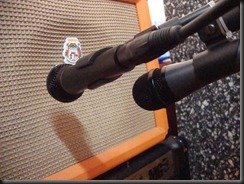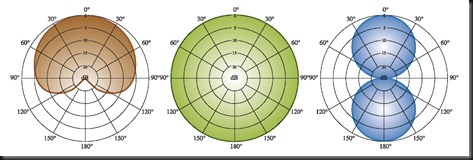Progress on all activities arround Slice his music and projects. The passion for music and taking the challenge. Come with us on this magical trip.
Friday 14 December 2012
Monday 10 December 2012
Wednesday 5 December 2012
Friday 16 November 2012
Sunday 4 November 2012
Tuesday 30 October 2012
Sunday 28 October 2012
Monday 22 October 2012
Monday 8 October 2012
Friday 5 October 2012
Pink Floyd - Comfortably Numb Pulse Live (2nd Solo) Cover
Please subscribe and leave a comment.
Thursday 4 October 2012
Wednesday 3 October 2012
Saturday 29 September 2012
Monday 7 May 2012
Technical & Creative.
I am nobody, however being nobody has made me free in a way, I have always been a mix of technical skills (sort of) and creative power (more imaginative than creative) both assets have been very handy to me over the years; however I can’t say that I have received greater success with one or the other. In truth, it has been the combination of both that has worked for me, with some other ingredients like patience, most of the times. I used to think that the technical knowhow was at the service of the creative process, that inspiration leads the way and technical resources paved it, however time and experience have taught me otherwise, not only this is not the case but it is a brutal misconception. I can extend on this concept in this post on many aspects of life and labour, but to stay in focus with my blog I will stick to the music and musical production, engineering & mixing context hoping this will allow me to restrain from divagating in to the clouds too much.
Producing music is undisputedly an art form, so is engineering and mixing however for different reasons but similar purpose. It is no novelty that a production, recording or a mix can kill a great song, the contrary is hardly possible since there is a requirement for good raw materials (MUSIC) a good song & a good performance can be enhance and polished to the status of great or even master pieces depending on the production and the post production.
Creativity as defined by Ken Robinson “Creativity involves putting your imagination to work in a sense, Creativity is applied imagination. Creativity is the process of having original ideas that have value”.
Technical is about the ability to master the gear at your disposal and manage it in the way that makes sense to you and fits the purpose you intend for it.
So when it comes to music production, it is clear, that good material will trigger a creative mind to have plenty of ideas (the question is ¿can they be made useful?). The production is the part of the creative process during the stages prior to recording, getting the songs ready and working with the band and the arrangements for the songs, getting the mood of the songs, the feel of what the band wants to express and help them focus their energy on getting the materials right, suggesting and being a constructive critique. To follow on with the work with the recording engineer and help in the process of capturing to tape or HD of the results of the preproduction stage in the interpretation, bridging and making the process as smooth as possible, helping and promoting every aspect, The responsibility is that of a coach but also a director, you will need to have a clear idea of what needs to be done. It is inevitable that in this process your talent and creativity will flourish and merge in the production. The Mixing and Mastering are the processes of balancing and placing everything in the song, and getting it ready for its final purpose. As a producer you have to pass down to the mixer the feel, mood and theme of each song. This is normally done with a rough or demo mix, or in other cases the producer, recording engineer and mixing engineer are the same person as in my case. The “Rough” as it is called has usually captured most of the mood, sound, the bands spirit or placement. Therefor the mixing is built with a base; as a mixing engineer use your own taste and experience in polishing up the different tracks and parts of each song, using the tools at your disposal.
The result of a musical production is a combination of skill, taste and creativity. But neither one of them are isolated domains. Creativity can help a mixer solve a technical problem, finding alternative ways of doing things, new creative ways to use the same tools to achieve innovative results. On the other hand technology can help the creative process by laying out new ways to see things that widen our imagination to new ways to do things. A new effect can inspire a new approach; the minimal change can move the entire song and trigger a response that may make the difference. Finally no matter how much creativity or technology you use you will need to use your taste to get the right measure and result.
Creativity is a process and as such must have its own milestones and tasks, in producing music creativity is a set of different episodes in the different parts of the production, but it is also a complete independent process. On the other hand technology is directly present at only some stages during the process, but it should always be present in our mind throw-out the entire process. In the creative part you need to focus on the emotional qualities of the music the feel, etc. However one must not limit creativity to these domains and seek applying it also to the sonic aspects witch are usually in the more technical domain. For me the key is the balance between technical experience and creative innovation.
Every song or piece of music has its own unique sound and sonic footprint; it is a hard but comforting job to find and fine-tune these qualities and polish them to they shine. Taste, emotional compromise and motivation will get you there where technology and creativity are mainly the tools of the trade. Exceptions apart if you are too technical all your songs will sound the same, if you are too creative your results will be all over the place. Keeping a balance of both by directing them with taste will bring new and imaginative results every time.
As always Thanks for reading I relay hope you enjoyed it.
Follow Slice at http://youtube.com/user/inside71slice
Wednesday 11 April 2012
Slice STW Project Update
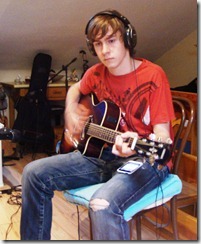 Slice recording Acoustic Guitar
Slice recording Acoustic Guitar
This past weekend we finished recording all acoustic guitars for the STW Slice “The Wall” project, things are coming together very fast on the musical end and we have just over a dozen tracks to record before we finish the recording stage of the project. hopefully in two or three weekends more we will have everything laid down. So far we have 90% of electric guitars, there is 1 guitar track for “Run Like Hell” that still needs to be recorded, it is some loose lick’s and accents, All but one of the bass guitar tracks are done, all acoustics are finished. What is still pending is Pianos for some of the songs, classic guitars, and an harmonic that will be used on the “Outside The Wall” song that closes the album. Next weekend we should be able to finish the classic guitar, the remaining bass and electrical guitar and one or two pianos. leaving the core of pianos and the harmonic to the weekend after next.
That is how we are on the recording side, on the post edition we have 15 songs edited and mixed 11 to go but for most the basics are already covered. So we should be ready for mastering by mid May. As for outputs, we will be making stems of all individual instrument tracks and a general stem of Slice’s mix on his own and a few final mix downs with the original song from the album as a backing track, with different levels between Slice and the original.
On the Video side of the project we are starting the planning phase, we intend to shoot all the video footage in the last week of June and beginning of July, and start editing in August, with some luck we should have the finals by October or at least before mid November. Just in time to get them all published on You Tube.
Keep tuned for more updates.
Follow Slice at http://youtube.com/user/inside71slice
Thanks for reading.
Ian Burt © 2012
Monday 26 March 2012
Business in Music part 2 of 2
http://jambooat.blogspot.com.es/2012/03/business-in-music-part-1-of-2.html
Saturday 10 March 2012
Business in Music part 1 of 2
This article was intended for a different platform and was written some time ago. I still see the things as I express in the following word, but there are some new considerations I have added in the time I did the first draft to this final. I will try to put in some closing notes to clarify myself. Otherwise I will leave the post in the original words.
Having a 16 year old son that wants to find his way in the music industry has made give many things in this world a great deal of thought. Once upon a time I also dream on becoming a musician, and make a living with my money. Since it was a dream I dreamt about making lots of money, fame and becoming a rock star. Truth is that things have changed a bit since those days, not just simple changes on genre or music styles, there is more competence, the market is different, the business is different, and basically nothing is the same.
In the 80s and 90s we consumed much less music than we do now, but we purchased more than now, not only in the amount of records but the budget that we had then for buying music was bigger than todays. So! ¿what has happened? The simple answer to this is that we have changed the way in which we consume music. The thing is that thou the consumers have moved their way of listening and interacting with music, the industry has tried with no result to remain in the same corner as 20 years ago. In the era of the vinyl records we would purchase 2 or 3 singles as they were released and finally the album that ended up including them. Technology moved along to the cassette tapes and singles where not that prominent but we still purchased the cassette. When the CD Rom appeared we all moved along, I have some albums in all 3 formats. We can now listen to music on an ever-growing array of devices, this has brought with it a liberation of where, we listen, how we listen and when we listen to music. The evolution of technology has introduce hole new culture of music consumption, we no longer have to be static net to the record player or limited in our mobility by Walkman’s or Discman's we all know where we can engage with music and with what ease. Music is not just hobby it has become the background sound track to our everyday activity. To the extent that younger generations take it for granted that music is present 24/7. What this new scenario were music is universal due to the unlimited access provided by the new and wider available technology platforms available, has provoked is that the old ways we obtained the music has become obsolete.
However the market or better said the industry has not been as fast at evolving. If we review the way vinyl records were sold and how CDs or DVDs are sold today there is no substantial change. The chain top to bottom has maintained its original form and players, maybe some minor changes have been introduced to improve processes but the core is the same. The major driver is that the stake holders have the same interest and roles and these are anchored to the past, this immobility of these historically accepted archetypes, is a net that has too much to lose. By looking at how has what to lose we can easily point out what is wrong in the current business model and the whole industry.
The Label or record company have been and still are a necessary stake holder. But their role needs to be reconsidered. They were the music Maecenas, to record an album or a song and to commercialize it was a very expensive venture, they would put the money up front to accomplish the project, you could say that they are like venture capitalist that invest in a musical project, the main difference being that the investment is the first to be deducted from any income from sales, plus they normally take the biggest chunk from the profits. The distribution chain is an endless stream of middle player whose only mission is to take the product from point A to point B being point B the commercial outlets something that is in great disuse now a days, places were consumers can pick-up physical copies in CD ore DVD, where big department stores sell the majority, leavening small and specialized musical stores out of business.
I will continue next week with part two of this article.
Please support Slice at http://youtube.com/user/inside71slice
Thanks for reading
Ian Burt © 2012
Saturday 3 March 2012
Slice “The Wall”
The STW project I have been talking about for the last months get’s its name from “The Wall”, an all time master piece album by the Pink Floyd. STW are the initials to Slice “The Wall”: Slice came up with the idea and is the only performing artist. We have been holding back disclosing this for a number of months, waiting to get some go-ahead's, we have decided to come out into the light, Why? well, why not?
The best way to answer is to explain what the project is about. Rock history knows that Pink Floyd released the album “THE WALL” one 30th of November of 1979, the album released as a concept album, where the motive and story behind main theme is well known. There is plenty of information on the internet and dozens of books, so going into it would be presumptuous on my part, others better versed than I have already provided extended and deeper knowledge, so how could I dare. Also common public awareness is the fact that “The wall” over the years has been represented through different platforms, as a live show, as a movie, etc. This brings us to Slice, During the “Roger Waters The Wall” tour through Europe, Slice and I had a chance to see the live performance in Madrid, both Slice and myself are great fans of Pink Floyd, in such a way that Slice has done a few covers for his YouTube channel in the past, of some of the most memorable songs of the band. After the show Slice came up with the idea of doing a cover of the entire album, all 26 songs. I thought that was a great challenge for him he was only 15 at the time, but at the same time the idea was new and surely rewarding if it was done right.
It took us 2 months to decide how we wanted accomplish the different tasks, the schedule, the method, as many bits and pieces as we could. We ended up with a huge list of thing, not big enough to put us off on our desire to embrace this project with all our strength.
Before I go into any more detail there are a few things that I need to clarify to avoid misunderstandings:
- The entire project is a non-profit quest, all Slice and I get out of this, is the cover and recreation of a master piece we both worship and admire, with the personal satisfaction that this brings with it.
- We will not publish this work to the public without the approval of the legitimate owners of the Copy Rights. (Roger Waters, David Gilmour and EMI Group Limited)
- The Cover will be published when permissions granted on YouTube on Slice’s Channel and will not be under the name STW or Slice The Wall these are code names during the project development stage, are not registered and hold no commercial value.
Having that out of the way, for what I am happy. Contact has been established with David Gilmour’s managers office in London and they have no objection to the project as long as the IP is not damaged or mistreated. We have sent the same request to Roger Waters office but haven’t received reply yet (witch is understandable being that he is in middle of a tour right now). We have been unable to contact EMI, there seems to be a logical barrier that we have not been able to overcome yet. We have left a few attempts via their web site but we have no idea if they have gone through.
Getting on with the project, Slice is going to record all guitars (Electric, Acoustic, Classic & Slide), Bass for all tracks and Piano on all tracks that have piano (not keyboards). in the 26 songs there are over 90 different parts, and some are going to be dubbed. that means nearly 150 tracks to be recorded. we started in August and have recorded 21 session with 87 tracks finished in total, where in most sessions Slice records between 6 and 8 parts, we have had to repeat some early recordings due to sound issues. Our target is to finish all the recording by April and have the mixing finished by July. There is still a fair way to go but we are more confident after every session.
Rough mix not the final thing.
After July and once the audio is all finished, mixed and mastered We will start editing recording and editing the core live performance video, All the video will be treated using the Chroma Key technique. There will be tons of footage we are using up to 6 cameras on every instrument part that sums up to 80x6 in the range of 500 video clips, that need to be selected arranged and edited. One of the things we decided early on, was that expecting to engage our potential viewers for an hour and a half on just a performance of slice would not cut it, we wanted to do something more without making a plagiarism of the film or show. keeping the viewers attention has been and still is a challenge that we haven’t quite solved. One thing that we are going to do is record a side story with Slice as the main character, where he tries to go through the different songs with a personal view, this has not yet taken since we are still working on the script and footage that needs to be decided. A great amount of this resource footage that will be recorded outside the studio, there for we are waiting for better weather.
There is also the Graphics, all Chroma video will be scored upon a virtual background that is being designed for all different scenes.
Please review earlier posts to get further details on the STW project.
I will continue to post on the progress of the project as we move down the schedule.
any enquiry or support please contact me at iaburt@hotmail.com
Support Slice by visiting his You Tube Channel at http://youtube.com/user/inside71slice
Thanks for reading, I hope you enjoyed.
Ian Burt © 2012
Saturday 18 February 2012
Sound Cooking
I am a one of the many loyal follower of the Pensado’s Place internet TV Show, I have included the last episode #54 just a few days before writing this post. one of the best episodes to my opinion.
Not to long ago, on another one of the episodes, a guest said something that made me change my entire approach to mixing, producing and making music. You all know and I have said before I am an amateur in the engineering and production of music, so I can’t stand for my own achievements in this field “YET”. However the concept behind this guest’s words, put a lot of thing’s into a brand new perspective for me. I can’t quote his exact words one by one, what he came to say is “that if his mother where to give him the recipe to her fantastic apple pie, he would not come close to making anything like his mothers pie”. I have spent tens of hundreds of hours listening to video tutorials, I have seen all 55 of the Pensado’s Place episodes and haver read books or anything that came into my hands on any aspect of music making. So what is it I discovered in theses words? well, the way I understood them, it’s not the recipe that is important, it’s the pie. If the pie is good and everybody like’s it, who cares about the recipe. The way in witch you cook the pie is just part of a process, nothing more than path to the product. This concept hit me hard and I have been giving it large amount of thought over the last few days, so here I am to share these thoughts with you.
Before I go into dissecting the subject, I want to define what to my understanding are some more metaphoric analogies between some elements in this sound cooking fields. The dish or pie is the final results, or I may say the Song or Mix. In any mix or song there are tracks, these would be the ingredients. The way they these ingredients are prepared could be the recording. The way they are used I will say is the massaging of the track, including EQ, compressor, filters, etc. The effects and plugins are the spices and condiments. The mixing is how you blend the ingredients (quantity, when they come in etc.). Mastering the cooking or baking of the dish. The cook can be both producer and the engineer. and last but not least, the presentation is the delivery.
Funny how we can relate to the cooking world so closely to music. ¿NO?
No two cooks will make the same dish when give the same ingredients. They will all treat the dish differently, work the ingredient, spice them, present them and cook them differently. All their results will be different, but I am sure that they will all be interesting and edible. Some will be more of our taste and some won’t but all will be valid dishes. ¿What way is good and witch is wrong? None, they are all legitimate, it will all depend on what we have a crunch for. it is the combination that brings the result’s and produces diversity.
To succeed in either one of these crafts, one will need to innovate, experiment, force the boundaries, go to the next level. Making the same pie that your mother made, is not the challenge and brings nothing new to the table, all that it can prove is that you have learnt how to repeat a process. There needs to be a distinctive and innovative signature to the result, something that makes it new and appealing, something that makes it yours.
It is unplayable to learn from the pros, I take very seriously the need to evolve technically, what I have learnt with this is that the important thing is what you learn and how you apply it to your own cooking. one of the fundamental lessons for me is that now I look at what they do in the creative and perceptive aspects of their crafts, rather than the technical. I take in both as a sponge, where the technical is a resource to the creative and creative is the driver to the technical.
The cook and the ingredients are fundamentals parts that contribute to the final dish, in music there is much more to it vs. cooking, the song it’s self as a product of a creative process and the interpretation make these ingredients unique. the uniqueness of these mark the rest of the process, where they can’t be cooked in the same way as other similar though different while also unique ingredient are handled.
I love cooking and I love making music, I am best at the former. Following the interviews on Dave Pensado’s show I have started to see how they correlate. The fundamental breakthrough for me is that technical skills are great to have but you have to put your secret ingredient into every dish you cook or song you mix or produce. This ingredient is love, passion, the ability to take in what you are working on. labour on it as it matures, find from experience, intuition, feel and taste, the essences of the piece at hand. Following recipes wont do it, you need to interpret the dish, and use your creativity, experience and talent to make the wonders of listeners or tasters. It needs to come in through your ears and gut and speak to you.
It is amazing how diverse al these engineers and producers are at all the different parts of the process, specially in the technical side of things, but also how much in common they have when it comes to putting feeling as the main driver to creativity even though the process of creativity is different to everyone of them. This is what makes their work sell and win the Grammy’s, I can’t speak for myself, but I have a much better understanding after listening to the experts.
To round it up. This new perspective has given me the chance to relax from my technical shortcoming's and focus on the musical side, listen to the music and try working on my own creative skills and musical taste, see form my less technical end what I can do for it. understanding that to be innovative taking risks is necessary, if I technically fail I can always start all over again. Holding one thing as the guide light in the tunnel The Result is what matters, not the way there. if something works don't try to find orthodoxy just feel it if it makes emotional senesce then it is right.
I want to thank al the Music lovers out there that are keen on sharing their knowledge with the world. this post is dedicated to you all.
http://soundcloud.com/ian-alexander-burt/slice-cover-abtw2
Today I haven't mentioned Slice, I have to include him as a PS please check out his channel on you tube, drop a comment and rate his videos.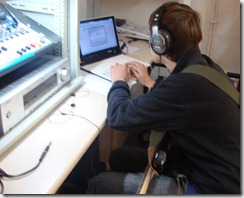
Thanks again and I hope you enjoyed the read.
http://youtube.com/inside71slice
Ian A. Burt © 2012
Sunday 12 February 2012
Slice STW, Production Management
In the past weeks, Slice has done great progress with the recording, he has laid down most the electric guitars and bass tracks for the STW project. The process has not been an easy walk through the woods, we have had to go over and over again with some tracks to get them nailed or as close to perfect as possible, well lets say the best possible performance that we could reach.
In the mean time I have not been idle, my attention has been on mixing all week long, there is a ton of material to put together.
The way we are doing this, is certainly not the standard procedure, for obvious reason it is not the most efficient way to get it done. In our discharge I must say that we do have some very highly imposed constraints, that force us into this manner of proceeding. Usually in the music business the recording of tracks for a record or a song will be done at the beginning before mixing, and in a short time frame, well at least the main tracks, usually when this is completed everything is ready and the mixing can start. This is the ideal scenario with no doubt, but we are far from this possibility in the STW Project. Slice is only available to record on weekend mornings (due to school, and other youth duties), so only so much can get done with this time limitation. He does have the entire week ahead for him to get all rehearsing of what he is going to record in the weekend, this normally makes recording very smooth, even so, while getting the perfect take and sound are everyday challenges that consume time, time that can not be spared. This leaves us with between 4 and 8 tracks per day and not much more that 10 per weekend on a good one. Just as a reminder the STW is a project where Slice will be doing over 140 separate tracks.
All the track’s are parts of individual instrumental pieces from different songs, we don’t record one song top to bottom in a consecutive session, on one week he will lay down the rhythmic guitar to a given song and the solo will be laid down two or three weeks later, the bass maybe another three or four weeks further back, it can take even longer to add piano or acoustic guitar. We have songs that have may have as few as two tracks or as many as five or eight to be recorded, meaning that wont have them complete for another two months yet. Among the different reasons for doing it like this are, first we need to rearrange the room when we change between instruments, the limited room acoustics need to be setup, and that has to be done with some time and planning, Secondly Slice is borrowing some of the instruments form some friends, This means that he need to schedule all parts with that instrument into a fixed agenda, so he plans the rehearsing and recording with this in mind. The consequence being that the tracks I can start working with are a mixture and only a partial part of the material I need to get a finished result.
Given this situation, ¿how do I work on it? ¿What can I do to to move ahead with the mixing? Well there is one advantage to working on Cover songs with the original recording as a backing track. You can fit in, one part at a time and work on the individual contexts of each instrument and how it merges with the original song. This provides a benefit giving me a chance to, massage each instrument individually and make sure it sits in at the best place with the original while giving it’s best as a cover part. It is like mixing that instrument as the last one, I will eventually pull all the cover tracks up and listen to the full mix, but to start I work on the individual instruments, making space and accommodating them in the picture. When everything is there I star with the full mix I usually do the initial accommodation with all the tracks and the original keeping a fair amount of volume on the original to maintain it’ as a reference for the mix, then when I feel that everything is square, I bring the original volume down to see if the covered instruments sit in well in unison. I trim volumes and all the automations here so that I feel I have as close enough a cover as possible to the original. I usually solo Slice’s tracks to make sure there is no hidden bugs or stuff. If the mix of the covered instruments sounds good It will merge well with the original. and that is my final stage. I pull the original back up and write the automation for the original track I usually bring the original down 3 to 4db while there is a cover part playing but bring it back up to unity if there is no content recorded by Slice, I try to give the mix a uniform volume as much as possible with the limitation that Slice’s covered parts do stick out over the original so that they can be heard and distinguished on the videos.
As a final thought, we are working from the inside out, putting the main parts that Slice will be covering in first. The first to go in is obviously always the original song, on top of this we start building our music, using the foundation of the master piece as a guide. It does help but it also means that you have to be extra careful, any mistake or difference gets magnified you are put up against the master and there is little room for fiasco, you need to focus and find the details and breath on them, find the energy and transmit it on the cover, feel the music and reflect it as your own as much as possible without damaging the original.
Slice makes covers of music he like, musicians he admires and artists he respects.
keep up to date with Slice @ http://youtube.com/user/inside71slice
Thanks for reading I hope you enjoyed.
Ian A. Burt ©
Monday 6 February 2012
A Slice of a dream.
I a 47 year old dad of a kid of 16 (Slice), am as good or bad as any other dad, my imperfection as notorious or rare as any other human. But when it comes to my son there is a passion that burns me from the inside and I can’t help myself. This is my statement.
What am I trying to say? Well, I honestly believe in Slice and his tremendous talent, of course I am his father, but more than just that, I see his ability with music, it flows naturally and it seems to be effortless for him. He still has a limited technique, something he will have to obtain with hard work, time and perseverance. His talent however resides in the ease with witch he gets the music flowing, it seems to pour out of his hands naturally as if it where always there, he reads a song or a melody with only a few bars. He has a special ear for details and can print the feel and the soul of a song, a solo or a lick up to the most unappreciable detail, squeezing the soul out of every note he plays or silence he creates.
“I have a dream”
I know it’s a sentence that has been used before, but I do, I have a dream, and is to see Slice get the chance. Yes a chance only that, I am 1000% committed to helping him get the chance he need, he will have to do the trick and convert it into anything else. but my priority is to work him up to the point where he can get the opportunity.
I believe in luck, luck as Julius Caesar said is where opportunity and preparation meet, Slice is working on the preparation part and I am focused on the opportunity bit. I am running al kind of social networking on his behalf, investing every penny I can get my hand on, working my personal relationships to the limit. I am learning any craft that can provide the door to opportunity, building every possible bridge, road, anything that can help me get Slice the one chance.
I have invested money in gear, instruments and training. I have invested time in many other ways. I am perfectly aware how hard the music business is, and the kind of life it is just to survive in this world. But I also know that there is no greater satisfaction than making music and sharing it with the rest of humanity, a concert is an electrifying experience in witch a musician reaches a binding with his audience that exceeds any other experience and makes it all worth while.
What father wouldn’t do the same? I want the best for him, I am also very strict on his studies, he is in Collage now and doing very well, he is already looking ahead to determine what University he will be attending in two years time. He understands that he can not place all the egg’s in one basket. Having options is not an option it is a must.
I can understand this is to no interest to anyone, but this is my blog and I felt like writing this.
ANY HELP WILL BE APRECIATED..
Really, if you have anything, idea, or any resource that can help this dad make his own dream come true. I will be so very thankful. contact me at mailto:iaburt@hotmail.com I will answer to every email.
Thanks for your time once again.
follow slice at http://www.youtube.com/user/inside71slice
Ian Burt © 2012
Wednesday 1 February 2012
Slice, writing music.
I have just finished seeing a video, that has marked me profoundly. It has been a real eye opener for me. The information has been there all along, but it has all come into context watching this video. The video is in Spanish, thou the main stream of the video is Eduardo Punset (Spanish Presenter) interviewing Ken Robinson. The interview has been dubbed to Spanish but you can make out the interview in the back ground. http://blip.tv/redes/redes-89-los-secretos-de-la-creatividad-4944707. If you can spare the time I recommend you pay a visit and view the video, I also recommend you get Ken’s book:
"The Element: How Finding Your Passion Changes Everything"
Ken Robinson; Mass Market Paperback; $10.20
In Stock
Sold by: Amazon.com LLC
Creativity, ¡wow!, what a word. I have always been a creative person, creativity is in most everything I do in my personal and professional life, But so are you in more than you may realise, I try to be as creative as possible in anything I undertake, posting an article every week or twice a week, requires a fair amount of creativity. But so does everything else we do on our every day lives, when we dress in the morning we use creativity to choose what to wear (some with more taste than others). Creativity is about the science of looking ahead into the future and taking decisions that affect the outcome of it. When you send an SMS, an e-Mail or comment on a social network there is some degree of creativity. From the video, I specially liked Ken’s comment explaining, that creativity is not something we have or we don’t have, like given thing, everyone in their own ways are creative. Creativity is like reading or writing, in the sense that are one is not incapable of writing or reading all they need is to learn how to. Creativity needs to be exercised and learnt but we all have it in us in a different ways. We all have a different approach and different ways of being creative but it is one of the fundamental differentiators of the human race for good and for bad. Bad because creativity is the basic ingredient in a lie, a lie is a product of someone’s imagination created for a purpose. But let me get back to my post.
For Slice, creativity is a territory still to be explored, a virgin land where he needs to take his first steps. Sorry, let me take that back. For Slice, creativity is something he is submerged in, however it is musical creativity he needs to focus on and explore. You can use a process or your knowledge and technical skills to create, anything that works for you is good. The thing is I don’t think this on its own would produce music as an art form, it may produce music but if it is limited it will be missing the soul. Slice has the technical skills and the knowhow. He is young so he still need to make the trip down into his inner self, into his own soul and find for himself what he wants to express and how as an artist (only then will we know how good he can get to be).
There is a moment in all musician’s life (Maybe all artists life but I cant tell for the rest) when they hit the source of inspiration. It is something they will never forget, it all becomes clear as water for him. It is a life changing moment, light is all of a sudden illuminating everything that was already there but not discovered. it all falls in place, he has done the journey and found the source of inspiration, the vehicle to express his personal self. There needs to be a communion between this new discovered world and the skills, where skills are put to the service of this realisation. From that moment on, it is all about working on both in parallel. Work is surely not the right word for it, it is more a vital passion that drives the process and when you give way to passion time seems to bend. Creativity in music is normally a combustive event a spark that captures an idea one instant that ignites a more complex process. The spark comes from inside and the moulding of this spark into a complete finished result is a process. during the process one take the spark or idea and dives into it, exploring it, breathing it, dissecting it, building on it.
There is not much that can be done to reach the point of inspirational and find this muse or spark. I don't have the silver bullet and can’t tell anyone how to get there, but I am convinced that dedicating time to experimenting with music and lyrics will smoothen the path. discipline is an effort that always pays back.
Slice has a long way to go and I am betting on him. There is nothing anyone can do to make him find the way, he has to find out by him self, the awareness of needing to find this inner fountain of ideas, won’t bring it up on its own, there needs to be a sincere process of personal meditation and interiorizing.
He is on his own and I hope he succeeds on this life trip.
Keep track of slice at his channel at http://youtube.com/user/inside71slice
Ian Burt © 2012
Saturday 28 January 2012
Slice’s Guitar Mod 0.1
Slice has been working on his main guitar for the last couple of week. this is a project to take his main axe form its original look and sound to a complete new level. in this first phase he has removed the original colour
And repainted it Black.
The neck has be repaired and smoothened out. A complete fret levelling, re-crowning and polishing was done. There has been some minor work done on the electronics but majorly to clean the wiring in the back, the nut needed a bit of scarfing, the instrument has been reassembled with the original pickups, neck and tremolo. because of the work done on it it was re setup. the intonation was checked and needed no further twitching.
Only on thing still to accomplish, we need a name for her.
Thanks for reading.
Checkout slice’s channel at http://www.youtube.com/user/inside71slice.
© Ian A. Burt 2012
Monday 23 January 2012
Amp Micing. The Slice way.
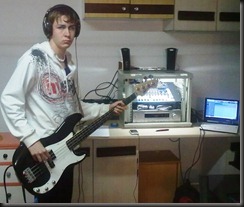 Slice recording Bass tracks for STW
Slice recording Bass tracks for STW
I had said on a previous post, that I would further explain my limited knowledge of amp mikeing. mikeing is an art form in it’s own way. There are a number of techniques and user specific trick but at the end it relies on a trial and error procedure and your own ear.
Before I start, I have my way of doing things. This is my personal approach, it is not a silver bullet and please do not take it as rules to follow, just use it as an ideas to investigate your own way on.
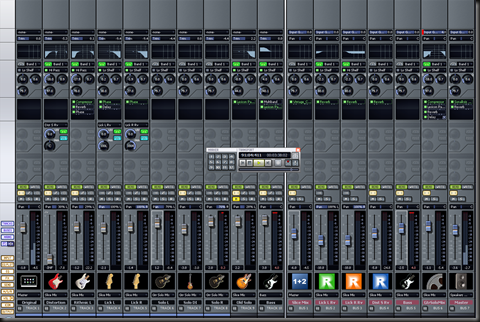 a Mix with several guitars most via miced amp.
a Mix with several guitars most via miced amp.
The first thing when mikeing an amp is to know what you are after. This requires that you have spent time with the artist and the producer and understand what it is they are looking for or better said listening for. I am going to narrow this post to guitar amps, but the same is true with almost any other instrument that may be amped.
It is impossible to set a rig up in any way if you don’t have a target, make sure you know all the parts that are going to be recorded and what tone and quality you are out to nail. There are normally a few things that are a given and you don’t have much influence on. The instrument, what guitar is going to be used is a very personal choice, and the relationship artist vs. instrument is almost a religious one. to a similar extent amps and stomp boxes or effects are also mainly artist chosen.
So how can you contribute to the sound. Well that is a no brainer, when something comes out of the amp it needs to be captured and in the capturing lays the secret. A bad mikeing and recording can ruin the best performance/guitar/amp combination and turn it in to noise. and in the same way a good mikeing and recording can bring trough another way's mediocre take. Needless to say joining the best of both, will deliver a spectacular track.
It seems there are some boundaries that we don’t want cross, but who say’s we can’t provide some advise and tips to the artist, that may help us in our job of getting it right.
First ask what choices of guitar he wants to use or has available, the same with the amp. Ask him to do a test track for each guitar (you won’t usually have to do this, they will request this them self’s, specially if they are accustomed to working in studio). To record the tests ask him if you can rig all the different amps he is thinking of (again this may not be needed) and if you have any specific amps available that you may think are suitable for the sound you are after and ask him if it is ok to mike them up also for the test. Who knows a blend may be just the right thing to get the ultimate tone. Get him to play around and listen to the different amps in the room, move them around until he is confortable. Try to avoid that he puts them to near any wall
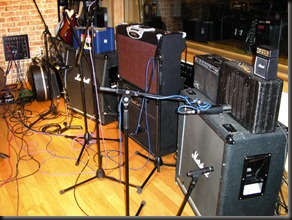 Amp array for test. Picture not mine
Amp array for test. Picture not mine ![]()
Let the artist to review all the recorded tracks for all amps separately and in different blend combinations. use your own ear to find sweet spots or problems an point them out to him.
Once he has settled on a number of amps (there is no limit other than common sense). you need to have studied the room you are going to record in. Share with him what areas suit the sound he is after the best. As a rule I keep all amps at least 1 or 2 feet form a back wall. Spend some time looking into the ambient sound of the room. Depending on what he is looking for you may or may not need an ambient mike so make sure you find the spots in the room that serve a good ambient and don’t mud up the sound. Highly saturated guitars in my experience don’t win much with an ambient mic, there are too many harmonics that the ambient resonance is not quite clear. In contrast clean sounds are greatly enhanced if you have a good ambient mic.
now we have the amps in place it is time to mic. I usually start one amp at a time and one mike at a time. I first work on the close up mic’s setting them at about one inch from the grid.
There are several standard locations for mikeing based on the distance of the mike form the cab’s grid. In the following figure I have label mike positions A through E
Position A is a close up mick flush the grid. Position B is a mike 1 or 2 inches from the grid. Position C is between 1 or 2 feet from the grid. Position D is further than 6 feet from the grid. Position E is an open back and mike is generally 0 to 6 inched form the open back.
Positions A & B are close up mikeing positions and will capture only speaker info depending on the mike choice, Positions C & D are ambient mike's with the difference that C will produce a tighter room image than D. Finally E will depend on the amp type, D is great to recording fat sounding guitar. The norm and needles to say this is choice, is to have 1 or 2 close up mike's and one ambient mic.
As we have said already ambient mike positioning depends on the ambient characteristics of the room. how ever close up mike's have a full array of different positions and settings that have to be experimented with. In general there are 3 positions to place the mike in front of the speaker. from the outside inwards as shown on the figure bellow.
The position further away from the centre is called the rim, the sound captured here is darker with greater amount of low and mid lows. On the cone or second position, the sound mellows up a bit and gets brighter. On the dust cap or centre of the speaker the sound is much brighter and losses some of the low frequencies retaining the mid lows. placing can be in any position you like but these are the three most common.
Warning! when using two mike's in a close up configuration on the same cab or speaker, the distance form the grid should be equal and if by choice you use different separations you will have to check for phase issue. Bare in mind that a phase issue can render on of the mike recordings useless. how ever there are plugins that can help solve the problem.
When placing a close up mike there are two ways you can position your mike in front of the speaker. Head on or off axis. In the head on configuration the mike is place perpendicular to the speaker at a 90º angle from the grid. The other configuration requires that the mike be at an angle between 30º and 60º form the grid (Note this applies basically to cardioid pattern mike’s).
It is paramount that you experiment with different settings and configurations, testing all positions and different mike choices. Never walk away from an amp and start recording without checking for as long as necessary for the tone you are looking for. This process may be very time consuming but will save lots of time and money later. It is best to do all this process before the artist arrives and save him from going through the hole thing. It is very lightly that the artist will want a twitch here and there but the Core has been done without him being there. they tend to get inpatient.
Microphones, this is a subject in it’s own and I don’t intend to extend on this topic here, but it is important that you understand the different patterns that they correspond to. In the figure bellow we have an example of the three basic patterns. A Cardioid, B Omnidirectional, C Bidirectional.
When used for recording an amp Cardioid is the predominant choice in the industry, however when recording ambient it is often a omnidirectional mike that is preferred. Unless certain reflections or room noise bleeding into the mike produce un wanted result. A Cardioid mike will capture sound coming in from the front of the mike and will filter out other sound coming from different sources. while a Omni will record 360 degrees around in all directions including sound coming from behind the mic.
Finally the consideration of the amp volume. it is best to get the sound from the amp without over saturation. This will require that the artist understand that a balanced output from the cabinet is fundamental for a good capture, it cant be too low or too loud (obviously depending on the desired result).
As I said at the beginning there is only one way trial and error, you have to try and try and try again until you get what you are looking for. I assure you that the result is worth the wile.
Thanks for reading and I really hope you enjoyed.
follow slice at http://youtube.com/user/inside71slice
© Ian Burt 2012
